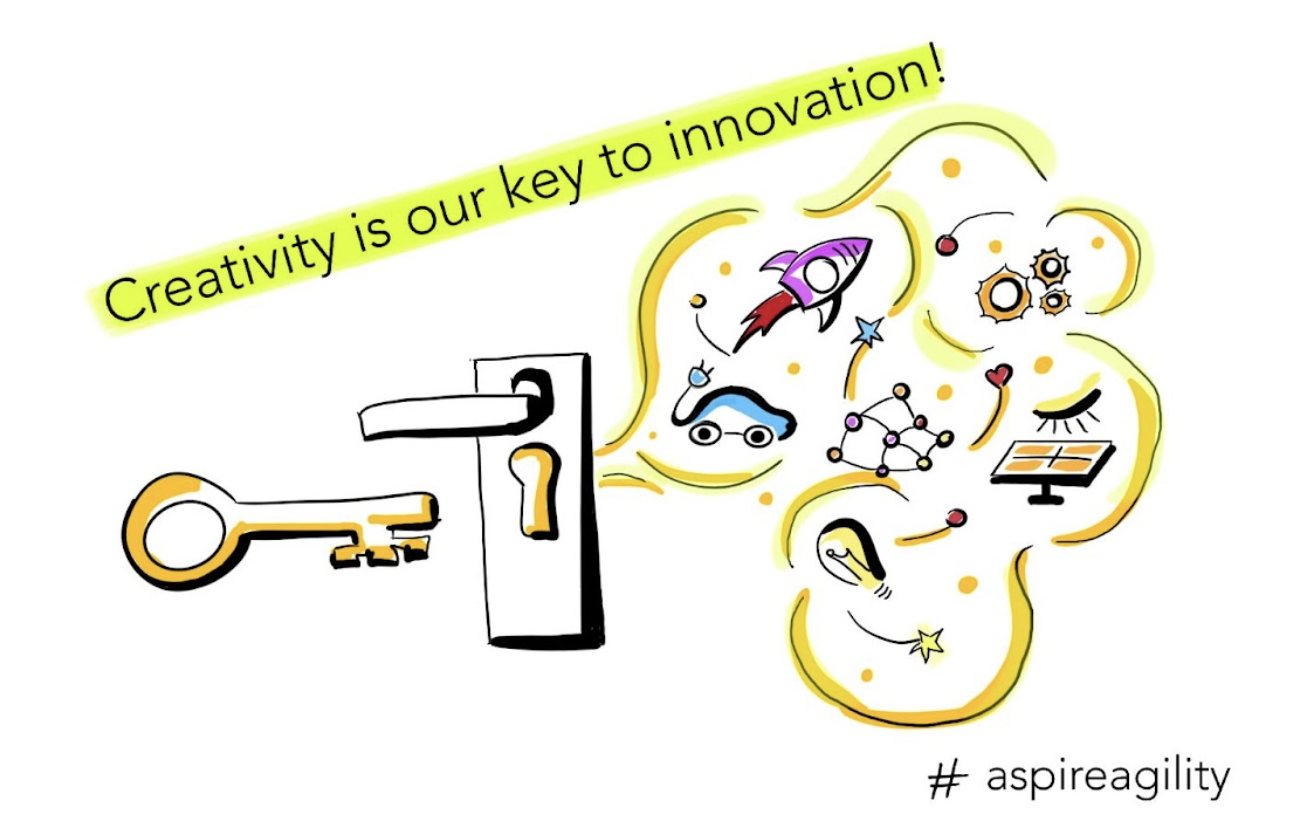Most of us can probably relate to the situation of struggle, when a problem just doesn’t want to get solved, no matter how hard we concentrate on it. “But later in the evening, while cooking, taking a walk or having a shower, the insight, solution or next hint is suddenly there, seemingly having arrived out of nowhere and in the blink of an eye.” No one can explain why it happened five hours later and not at the moment when it was needed the most. Neuroscience is just starting to understand the process of creativity, insights, ideation and intuition.
Yet, we humans are creative from birth. We are reminded of this when looking at young children playing. Unfortunately, as adults we rarely have the pleasure of using our creativity. Logical thinking dominates the world and our education system. Such terms as creativity and creation, empathy, spirituality, and intuition are frequently stigmatized and neglected. We are becoming more and more specialized, but do not synthesize enough. We seek efficiency and forget that effectiveness, innovation and creativity are interconnected.

According to the World Economic Forum, creativity is listed as one of the top 5 professional key skills by 2025. We solve 40% of our problems logically and rationally; the remaining 60% are solved by creative processes and by intuition (Estanislao Bachrach refers in “The Agile Mind How Your Brain Makes Creativity Happen” to the research of Mark Beeman from Northwestern University, US).
And indeed, creativity is the crucial force for the ability to innovate. The companies from the digital economy, technology and knowledge industry must be innovative in order to avoid being disrupted and/or act disruptively themselves. Innovation is a key competitive advantage in the volatile and complex world of the so-called VUCA. Some companies choose to emulate innovation, some choose to innovate. Second movers have advantages in certain markets. Last but not least, due to the speed with which similar features, similar frontends can be developed. They also tend to organize their processes based on external best practices. This can be a trap - organizations do not develop a long-term culture of innovation & organizational processes that lead to innovation. They develop products without a USP, which results in a company acting with their copycat products in a lower price segment.

Creativity and innovation are superpowers in the VUCA world
Creativity is our door to innovation. It makes innovation more diverse and differentiated. It’s more than just a UX design, a frontend or an app. It is product, system and technology innovation in one or more combinations. Also, Agility can be seen as organizational and system innovation.
In our business life we need creativity and innovation constantly to be able to:
- React to the changes that surround us
- Stand out in the market with our products, solutions or services
- Bring up individual and desirable products with real value for the customer
- Recognize and define problems by empathizing with and talking to customers
- Generate diverse ideas to solve these problems, synthesizing different dimensions and knowledge areas
- To be able to combine technology, data, knowledge, processes and individuality into the valuable offer for the customer
- To be able to define a solution and convince others with arguments in favor of this solution
How can we get into the habit of creativity and innovation and start creating?
Although we can’t predict whether we will get the insight or when it will come to us, we can certainly create positive circumstances for creative and innovative work. To work creatively, three components are important: domain or expert competence, knowledge of creative methods, self-motivation and curiosity to experience creativity.
Here are some creative methods and tips for the start.
Use creative methodology and processes
One creative methodology is particularly well suited to work in a business and technology context. Creative Problem Solving (CPS) is a holistic process that leads you through empathizing, fact-finding and problem definition. We call it the definition of creative challenge. It gives you hints and “how to’s” for ideation and solution finding. CPS also includes the phase of acceptance finding for the desired solution, which increases the chances to implement the desired idea inside of the organization. Rene Vidal in his paper “Creativity for Operational Researchers” explores CPS and gives a good overview on creative tools and approaches that can be used in each phase of the creative problem-solving process.
Produce many ideas
Linus Pauling, renowned US scientist and recipient of the Nobel Peace Prize and another one in Chemistry, once said: “The way to get good ideas is to get lots of ideas, and throw the bad ones away.”
So, follow Linus Pauling’s advice and try to produce many ideas. Creative agencies during ideation sessions ask participants to produce up to 60 ideas per hour.
Run creative work within your team
Look also into facilitation techniques. Ideating in a diverse group is much more effective and pleasant than doing it alone. The process and outcome benefit from diverse perspectives, reflection and expressing thoughts vocally. Ideating in a group requires a safe space in order to have a fruitful collaboration. Looking into the concept of safe space might be a good idea. Julia Shalet in her book “The Really Good Idea Test” writes about how to create a safe space for your team to share ideas.
Give yourself time for insight to arrive
Ideas can arrive at any time, but more frequently they arrive when we are relaxed and no longer focusing on the problem. So, give yourself time for the insight to arrive. If you are alone, it’s good to change between concentrated sessions and breaks. The Pomodoro technique is a good example of balanced solo work. If you are working on creative challenges with a group of people, include physical activities like “walk & talk” into your work. We also tend to forget the majority of our thoughts and ideas, so keeping notes can be helpful.
Get in touch with experts for consultations
Innovation processes take place in teams. With the right methods and learning experiences, it is possible to integrate creative processes into everyday work and reanimate creative muscles. If you are interested in increasing innovation and creativity in your company, organization, department or teams, we would be happy to help you.

